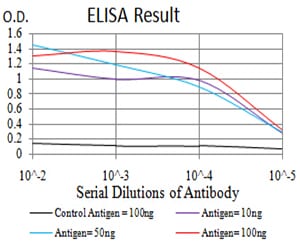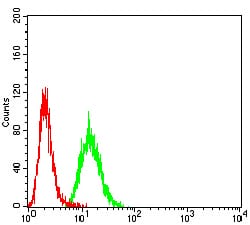

| WB | 咨询技术 | Human,Mouse,Rat |
| IF | 咨询技术 | Human,Mouse,Rat |
| IHC | 咨询技术 | Human,Mouse,Rat |
| ICC | 技术咨询 | Human,Mouse,Rat |
| FCM | 1/200 - 1/400 | Human,Mouse,Rat |
| Elisa | 1/10000 | Human,Mouse,Rat |
| Aliases | FOP; ALK2; SKR1; TSRI; ACTRI; ACVR1A; ACVRLK2 |
| Entrez GeneID | 90 |
| clone | 2C1E8 |
| WB Predicted band size | 57.2kDa |
| Host/Isotype | Mouse IgG1 |
| Antibody Type | Primary antibody |
| Storage | Store at 4°C short term. Aliquot and store at -20°C long term. Avoid freeze/thaw cycles. |
| Species Reactivity | Human |
| Immunogen | Purified recombinant fragment of human ACVR1 (AA: 21-120) expressed in E. Coli. |
| Formulation | Purified antibody in PBS with 0.05% sodium azide |
+ +
以下是关于ACVR1抗体的3篇代表性文献及其摘要概括:
---
1. **文献名称**:*A monoclonal antibody against ACVR1 alleviates heterotopic ossification in fibrodysplasia ossificans progressiva (FOP)*
**作者**:Hino K. et al.
**摘要**:研究开发了一种针对ACVR1受体(突变型)的单克隆抗体,可特异性抑制异常激活的BMP信号通路。在小鼠FOP模型中,该抗体显著减少异位骨化,为FOP治疗提供了潜在药物候选。
---
2. **文献名称**:*Targeting ACVR1 in FOP: Preclinical evaluation of antibody-based inhibition*
**作者**:Williams E. et al.
**摘要**:通过体外和体内实验验证了一种人源化ACVR1抗体的疗效,证明其能阻断突变ACVR1与配体Activin A的结合,抑制下游Smad1/5/8磷酸化,并在FOP模型小鼠中有效延缓疾病进展。
---
3. **文献名称**:*Mechanism-driven design of ACVR1-neutralizing antibodies for fibrodysplasia ossificans progressiva*
**作者**:Lees-Shepard J.B. et al.
**摘要**:基于ACVR1蛋白结构的抗体设计策略,筛选出高亲和力抗体,可特异性识别突变ACVR1的激酶结构域,阻断异常信号传导,且在细胞实验和小鼠模型中均表现出显著的抗骨化效果。
---
这些文献聚焦于ACVR1抗体的开发、机制验证及治疗应用,为FOP等骨化异常疾病提供了研究方向。
ACVR1 (Activin A Receptor Type 1), also known as ALK2. is a transmembrane serine/threonine kinase receptor involved in the bone morphogenetic protein (BMP) signaling pathway. It plays critical roles in embryonic development, skeletal formation, and tissue homeostasis. Dysregulation of ACVR1. particularly gain-of-function mutations (e.g., R206H), is linked to fibrodysplasia ossificans progressiva (FOP), a rare genetic disorder characterized by progressive heterotopic ossification. In FOP, mutant ACVR1 causes aberrant BMP signaling, triggering soft tissues to transform into bone. Additionally, ACVR1 is implicated in certain cancers, including diffuse intrinsic pontine glioma (DIPG), where mutations drive tumorigenesis.
ACVR1-targeting antibodies are therapeutic tools designed to inhibit pathological signaling. These antibodies typically block ligand binding (e.g., Activin A, BMPs) or receptor activation, thereby suppressing downstream Smad1/5/8 phosphorylation. In FOP, antibody-based strategies aim to neutralize hyperactive ACVR1 mutants to prevent ectopic bone formation. In oncology, targeting ACVR1 may hinder tumor growth by disrupting pro-survival signaling. Current research includes monoclonal antibodies and ligand traps, with some candidates in preclinical or early clinical trials. Challenges include ensuring specificity to avoid disrupting normal BMP functions and optimizing delivery to affected tissues. Recent advances in structural biology have enabled the design of conformation-specific antibodies that selectively target mutant ACVR1. minimizing off-target effects. These antibodies represent a promising avenue for precision therapy in FOP and ACVR1-driven cancers.
×